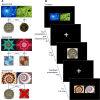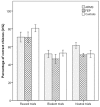Abnormal reward prediction-error signalling in antipsychotic naive individuals with first-episode psychosis or clinical risk for psychosis
- PMID: 29748629
- PMCID: PMC6006166
- DOI: 10.1038/s41386-018-0056-2
Abnormal reward prediction-error signalling in antipsychotic naive individuals with first-episode psychosis or clinical risk for psychosis
Abstract
Ongoing research suggests preliminary, though not entirely consistent, evidence of neural abnormalities in signalling prediction errors in schizophrenia. Supporting theories suggest mechanistic links between the disruption of these processes and the generation of psychotic symptoms. However, it is unknown at what stage in the pathogenesis of psychosis these impairments in prediction-error signalling develop. One major confound in prior studies is the use of medicated patients with strongly varying disease durations. Our study aims to investigate the involvement of the meso-cortico-striatal circuitry during reward prediction-error signalling in earliest stages of psychosis. We studied patients with first-episode psychosis (FEP) and help-seeking individuals at-risk for psychosis due to sub-threshold prodromal psychotic symptoms. Patients with either FEP (n = 14), or at-risk for developing psychosis (n = 30), and healthy volunteers (n = 39) performed a reinforcement learning task during fMRI scanning. ANOVA revealed significant (p < 0.05 family-wise error corrected) prediction-error signalling differences between groups in the dopaminergic midbrain and right middle frontal gyrus (dorsolateral prefrontal cortex, DLPFC). FEP patients showed disrupted reward prediction-error signalling compared to controls in both regions. At-risk patients showed intermediate activation in the midbrain that significantly differed from controls and from FEP patients, but DLPFC activation that did not differ from controls. Our study confirms that FEP patients have abnormal meso-cortical signalling of reward-prediction errors, whereas reward-prediction-error dysfunction in the at-risk patients appears to show a more nuanced pattern of activation with a degree of midbrain impairment but preserved cortical function.
Conflict of interest statement
TWR is a consultant for and receives royalties from Cambridge Cognition; is a consultant for and received a research grant from Eli Lilly; received a research grant from GlaxoSmithKline; is a consultant for and received a research grant from Lundbeck; and is a consultant for Teva, Shire Pharmaceuticals, Mundipharma and Otsuka. PCF has consulted for GlaxoSmithKline and Lundbeck and received compensation. ETB works half-time for GlaxoSmithKline. The remaining authors declare no competing interests.
Figures




Similar articles
-
Dysfunctional insular connectivity during reward prediction in patients with first-episode psychosis.J Psychiatry Neurosci. 2016 Oct;41(6):367-376. doi: 10.1503/jpn.150234. J Psychiatry Neurosci. 2016. PMID: 26854756 Free PMC article.
-
Altered neural signalling during reward anticipation in children and early adolescents with high psychotic-like experiences.Neuroimage Clin. 2025;45:103756. doi: 10.1016/j.nicl.2025.103756. Epub 2025 Feb 16. Neuroimage Clin. 2025. PMID: 39983553 Free PMC article.
-
Ventral Striatal Dysfunction and Symptom Expression in Individuals With Schizotypal Personality Traits and Early Psychosis.Schizophr Bull. 2018 Jan 13;44(1):147-157. doi: 10.1093/schbul/sbw142. Schizophr Bull. 2018. PMID: 27798223 Free PMC article.
-
[Brain imaging of first-episode psychosis].Encephale. 2013 Sep;39 Suppl 2:S93-8. doi: 10.1016/S0013-7006(13)70102-7. Encephale. 2013. PMID: 24084428 Review. French.
-
A Meta-Analysis of Neural Correlates of Reward Anticipation in Individuals at Clinical Risk for Schizophrenia.Int J Neuropsychopharmacol. 2023 Apr 17;26(4):280-293. doi: 10.1093/ijnp/pyad009. Int J Neuropsychopharmacol. 2023. PMID: 36893068 Free PMC article.
Cited by
-
Belief Updating in Subclinical and Clinical Delusions.Schizophr Bull Open. 2022 Dec 14;4(1):sgac074. doi: 10.1093/schizbullopen/sgac074. eCollection 2023 Jan. Schizophr Bull Open. 2022. PMID: 39145350 Free PMC article.
-
A multicentre study on grey matter morphometric biomarkers for classifying early schizophrenia and parkinson's disease psychosis.NPJ Parkinsons Dis. 2023 Jun 8;9(1):87. doi: 10.1038/s41531-023-00522-z. NPJ Parkinsons Dis. 2023. PMID: 37291143 Free PMC article.
-
Cross-species translational paradigms for assessing positive valence system as defined by the RDoC matrix.J Neurochem. 2025 Jan;169(1):e16243. doi: 10.1111/jnc.16243. Epub 2024 Oct 28. J Neurochem. 2025. PMID: 39463161 Review.
-
Ventral Tegmental Dopamine Neurons Participate in Reward Identity Predictions.Curr Biol. 2019 Jan 7;29(1):93-103.e3. doi: 10.1016/j.cub.2018.11.050. Epub 2018 Dec 20. Curr Biol. 2019. PMID: 30581025 Free PMC article.
-
The Role of Dopaminergic Genes in Probabilistic Reinforcement Learning in Schizophrenia Spectrum Disorders.Brain Sci. 2021 Dec 22;12(1):7. doi: 10.3390/brainsci12010007. Brain Sci. 2021. PMID: 35053751 Free PMC article.
References
Publication types
MeSH terms
Grants and funding
LinkOut - more resources
Full Text Sources
Other Literature Sources
Medical

